“You HAVE to go to a doctor!”
“Yeah, I guess.”
“Seriously… I’ll make an appointment for you. Your fever was 101 yesterday, and it’s 102 today. A 102 fever is a legitimate, doctor-worthy fever.”
“Alright.”
Martha was right. I needed to see a doctor. It had been several days since Highland Sky 40 Miler. Martha and I started the race together. After 10 miles, I was struggling to match her pace. After 20 miles, I told her that there was no way I could keep up with her, so she should go ahead. After 40 miles, I dragged my feet across the finish line, spent, as exhausted as I’ve been after 100 milers. And while I should have started to feel better in the following the race, my condition declined day by day as my fever rose. By Wednesday, I hit 102. I was able to get an appointment for Thursday afternoon.
“Are you going to be able to make it to your doctor’s appointment this afternoon? I think my mom can take you if you can’t drive yourself.”
“No, I can make it.” I was starting to feel better. I even considered cancelling the appointment. “I’ve been thinking, though… This illness… I’m not snotty or coughing, and my stomach feels fine. There’s no respiratory or gastrointestinal component. That’s sort of odd, right?”
“Yeah, it is,” she agreed.
I was looking for some validation for a wild theory. Since she is an infectious disease researcher, I could defer to her judgement. “I was thinking about the last few months. Remember a couple of weeks ago, when we did that long run? Remember how much I struggled? You could hardly run slow enough for me to keep up. All of our runs have been like that recently.”
“I don’t know why. It’s so weird!” It was a sentiment that she had expressed many times in the past, as I had found it harder and harder to keep up with her.
“And not just recently,” I continued. “The last few months have been really bad, but I’ve been struggling for longer than that. I really haven’t been able to run long for a couple years. Everything over an hour reduces me to a shuffle.”
“Right.”
“What if this fever is related to all of that? I mean, the obvious assumption is that I’m just sick because I was immunocompromised from the hard effort of the race last weekend. But what if I was sick before that? All of the difficulty and fatigue I’ve had over the last couple of years could be the real thing, and maybe this fever is just a new symptom.”
“That could be,” she agreed.
“So I looked at my race result, you know, for my entire race history — all the marathons and ultramarathon and everything over the last decade. Every year, I was getting faster and faster, winning and placing in more races every year through 2009. Then, I ran well in the Spring of 2010, and had a good race at Massanutten 100 Miler. I remember pulling a few ticks off of me at the end of the race. And I remember some other racers did the same. That was the turning point. After that, I had a couple of good races, but overall, that was a turning point. After the Spring of 2010, I was nowhere near the runner I was before then. Maybe I have Lyme disease, and it’s been progressing slowly over the last three years.” It made sense to me, but Lyme is a hypochondriac’s delight. It can present as a wide variety of symptoms; any sort of malaise or general achiness could be falsely flagged as Lyme. If Martha was skeptical, I’d drop it, and leave the diagnostics to the professionals.
“Hmm… That’s interesting… You should definitely ask the doctor to test you for Lyme.”
My fever broke an hour before the appointment. I arrived at the doctor’s office feeling like the trip and my concerns had all been wasted effort. Despite feeling like it was a long shot, I did request that the doctor test me for Lyme. She declined, dismissing my self-diagnosis with barely a second thought. As it seemed that I had made an abrupt recovery, there wasn’t much to do, other than send me on my way. I did try to get some conjecture about what sort of illness I might have had — what could have made me so sick, with no respiratory or gastrointestinal symptoms. I knew that aside from my own curiosity, Martha would be interested in a firm diagnosis. But the doctor was unable or unwilling to provide an answer. So drove myself home, where I promptly started shivering, and my temperature returned to 101.
The doctor called me the following day. “Hi, I know that you wanted a diagnosis. I was thinking about your case last night. I think I know what the problem was.”
“Great!” I was thoroughly sick once again, and I was happy that the doctor was giving me some attention. “What is it?”
“I think you are suffering from heat exhaustion from the race you did last weekend.”
“Heat exhaustion?”
“Yes,” she explained, “when you work very hard, you body’s ability to cool itself sometimes…”
“No, I know what heat exhaustion is. I’m just not sure that that’s the case. The weather during the race was fine. It was overcast, and in the 60s for the whole day.”
“That may be,” she continued, “but it was 40 miles. That’s an extremely long distance to run. Even on a cool days, it is a tremendous stress to your body.”
“I mean… You know… I know it sounds like a long way. But in the grand scheme of things… You know… The big picture… Like, I’ve done a lot of races that long. And longer! I don’t think that that’s anywhere near my limit.”
“What you need to remember, though, is that now you’re 36, not 16. I’m not saying that you’re ‘old’ by any means. However, you are at an age where perhaps you need to dial back your expectations of what you can do. People just aren’t made to run long distances like that.”
There was only one possible response. “Thank you,” I told her, “I’ll keep that in mind.” I needed to find a new doctor.
The next doctor was an infectious diseases specialist. Due to factors out of my control, it was a week before I was able to get an appointment. By then, my fever had mostly subsided (though on any day, I might be running a slight temperature). Unfortunately, an array of new symptoms started to present. I was extremely tired and occasionally dizzy, I developed severe skin sensitivity and I would drench the sheets with sweat every night. Martha wanted to come to the doctor with me. I was happy to have her as an advocate who could talk to the doctor with more authority than I could.
The infectious diseases doctor performed a routine examination, and ordered some standard blood work. He confidently declared that I would be better within a week. Martha pushed for a specific diagnosis. “Enterovirus,” he said. But Martha didn’t buy it. She tried to debate him, explaining why she didn’t think that was a likely diagnosis. She asked him to test for Lyme. We brought a copy of my race results in the hopes that we could quantify my decline. The doctor glanced through them, and declared that while my times are a little slower than they once were, I’m still faster than most people. “If you had Lyme, you wouldn’t be able to run a three hour marathon!” We tried to explain that a three hour marathon is a world away from the 2:35 marathons I had been running fairly regularly before 2010. Still, though, he refused. “It’s an enterovirus. You’ll feel better in a week.”
As we left the office, Martha ranted, “He doesn’t know! He has no idea! We’re supposed to respect the doctors, like they have all the answers. But he just felt your lymph nodes and made a guess! It’s… It’s… I’ll tell you what it is: It’s medieval! He might as well set some leeches on you! He might as well say that your humors are out of balance! We need to make an appointment with Dr. H!”
“You think we’ll get a different answer? I’m not sure it’s worth making an appointment with yet another doctor.”
“Dr. H will listen to you. You’ll need to be assertive, but he’ll listen.”
Dr. H was on vacation, so it was yet another week of fatigue and illness before I could get an appointment. At some point, I started tracking my symptoms. Each day was a different set of symptoms: fatigue, night sweats, rashes, skin sensitivity, dizziness, nausea, and most concerning, arrhythmia. Some days were better than others, but even on my best days, I was in a constant fog, napping several times a day to stay functional.
When the time for my appointment arrived, Martha briefed me on Dr. H. “You need to be assertive. He’ll listen to you, but you need to be assertive.”
“Assertive. Got it.” But I didn’t have it. I wasn’t entirely prepared for his line of questioning.
I happened to be having one of my better days when I saw him. He started the consultation by asking, “What symptoms of the illness you called about are you experiencing right now?”
“Right now? Right now I’m not experiencing any symptoms.”
“Okay, then what symptoms were you experiencing on the day that you called to make the appointment?”
“Well, on that day, I believe that I was a little bit fatigued, but I was generally alright.” I spoke from the perspective of someone who had spent the previous month waking up in the morning not knowing whether I would be able to get out of bed during the day, and grateful for the days when I felt relatively normal.
Dr. H, however, was approaching the problem systematically, with the assumption that I was a patient looking for a diagnosis of an illness that was proceeding in an arc of several days or weeks. Growing impatient, he sighed. “When you called to make the appointment, there was some reason, right?”
“Yes. Absolutely. Maybe I should just describe the situation from the beginning…”
“No, no, no,” he cut me off. “I think I know how to get the information I need. Let me ask you several questions, and we’ll figure this out.” He proceeded to ask me a series of questions that did allow me to describe the range of symptoms I had experienced in the preceding month. I described my progression from what seemed like a standard, febrile illness to one that involved a strange array of ever-shifting symptoms that might present or not on any given day. By the end of the interview, he had received a fairly thorough picture of the month since I first started experiencing acute symptoms. “So,” he was ready to conclude, “at this point your primary symptom is the extreme fatigue you described. You are starting to feel better than you have, but you want to know of there is any treatment that can help your recovery. Is that a fair statement of the problem?”
I took the opportunity to respond to the first open-ended question he had posed. “No! The real problem is that for the past decade I’ve been a fast, competitive long distance runner. I was getting faster and faster every year until the Spring of 2010. I had several good races in the Spring of that year, then I did a long trail race. At the end of the race, I pulled several ticks off of me. I thought I got all of them, but ever since then, I’ve been struggling with my running. My race standings dropped precipitously. I’ve been getting slower and slower. By this summer, every run would leave me exhausted. It was only due to this past month of severe, acute illness that I finally took a look at the larger picture to put everything together. I think I got Lyme disease at that race in 2010. I want you to test me for it.” It had all come out in a single breath, blurted without a pause or break.
Dr. H paused for a moment, in case I had any more to say. “Well why didn’t you tell me that earlier? We’ll test you for Lyme and babesiosis, for Epstein-Barr and Cytomegalovirus…” He probably listed a few others, but I don’t recall what they were.
A week later, the doctor’s office called. “Your test results came back. Everything was negative except for the Lyme test. Dr. H wants to start you on three weeks of doxycycline as soon as possible.” (In a follow-up visit with Dr. H a few weeks later, he insisted on showing me my lab results. He assured me that while the raw results aren’t of interest to most patients — they require a bit of interpretation — mine were noteworthy because they, “lit up like a Christmas tree.” Apparently, according to the test, I was as clearly and thoroughly infected as someone could be.)
Many people who receive delayed treatment for Lyme experience prolonged or chronic symptoms. I was tremendously fortunate in that the antibiotics had an immediate effect. Within two days, the acute symptoms had disappeared. Within 10 days, I was feeling better than I had in at least a year. Within a month, I was an entirely new person.
By the Spring of 2013, before my symptoms had become acute, I had come to accept that I could no longer run competitively, that at the end of the work day I would only have the energy to make it to the couch to collapse with exhaustion, that every morning, no matter how much sleep I got the night before, I would wake up dizzy and exhausted and never feel fully rested. Over three years, I had aged three decades. The process was so steady and gradual that I never quite noticed it. Then I took three weeks of antibiotics, and then another three weeks (which I requested after hearing the consensus among many long-term Lyme sufferers that three weeks is not enough), and in the following three months — from the middle of August to the middle of November, I gained back those three decades.
As I write this, in the first few days of 2014, I’m excited about the future. If there are lingering effects of the Lyme, they are small. I have run one race post-Lyme — a 100km race I run every year. I felt better at mile 60 this year than I felt at mile 10 last year. Looking back, it’s hard to believe I dragged myself through that distance last year in the state I was in. I haven’t yet regained all the fitness I lost, but I’m on my way. And now that I’m healthy again, everything feels just so much easier.


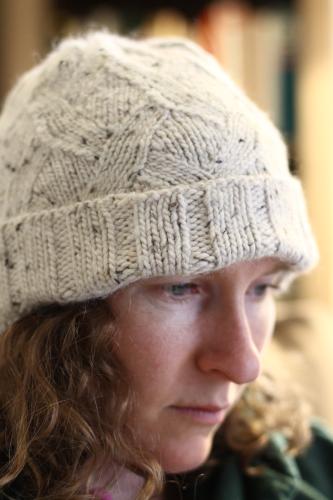
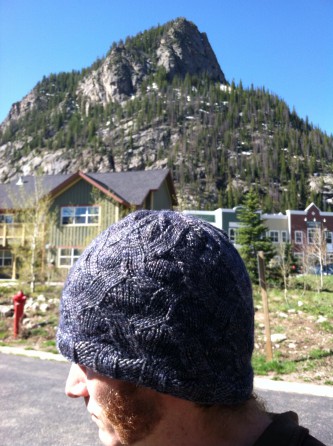


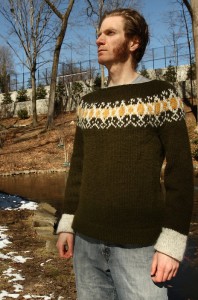





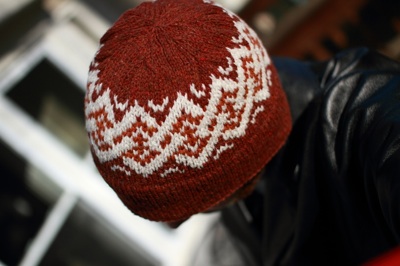 This one has a hemmed brim, and a repeating, overlapping pattern that is made “jogless” by a bit of special trickery at the end of each round. The only special skill (aside from knit, purl, ssk, k2tog and basic stranding) that’s required is a provisional cast-on. Usually, before I begin a project with a provisional cast-on, I’ll look up a little refresher.
This one has a hemmed brim, and a repeating, overlapping pattern that is made “jogless” by a bit of special trickery at the end of each round. The only special skill (aside from knit, purl, ssk, k2tog and basic stranding) that’s required is a provisional cast-on. Usually, before I begin a project with a provisional cast-on, I’ll look up a little refresher.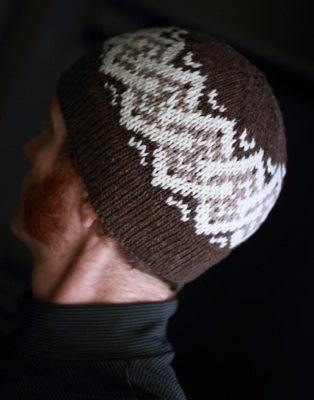 The pattern calls for three yarns: a main color #1 (MC1), a main color #2 (MC2) that is in the same color family as MC1 and a contrast color (CC) that is white or off-white. If you are so inclined you can skip MC2, and just use MC1 for the entire hat. And, of course, if you go crazy and use something wild for the CC, small children won’t die.
The pattern calls for three yarns: a main color #1 (MC1), a main color #2 (MC2) that is in the same color family as MC1 and a contrast color (CC) that is white or off-white. If you are so inclined you can skip MC2, and just use MC1 for the entire hat. And, of course, if you go crazy and use something wild for the CC, small children won’t die.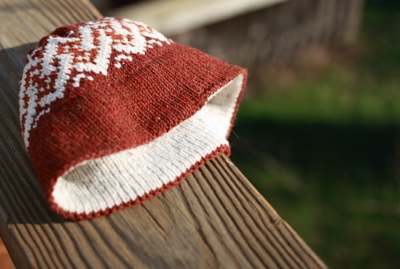
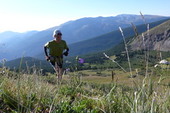
 Home
Home